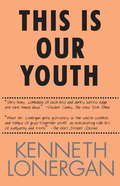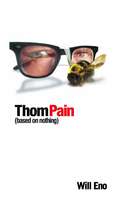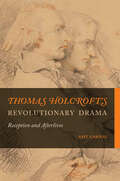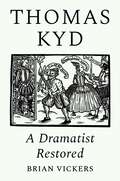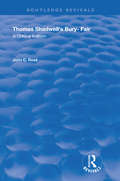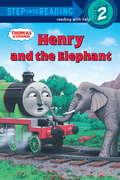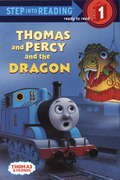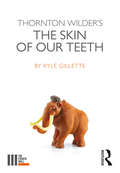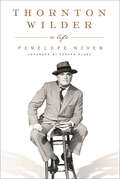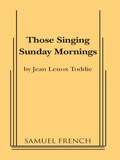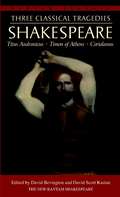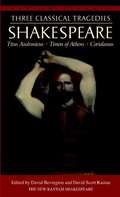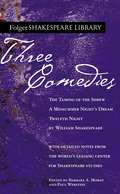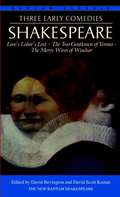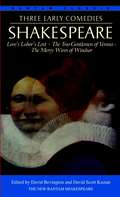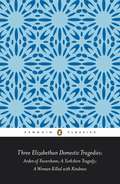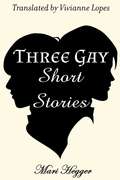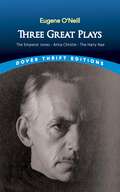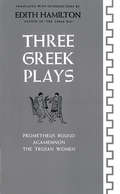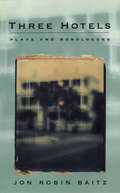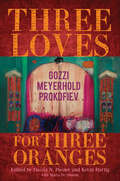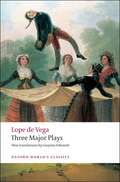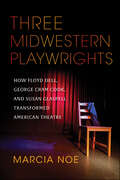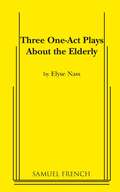- Table View
- List View
This is Our Youth
by Kenneth LonerganThis Is Our Youth, Kenneth Lonergan's lacerating look at affluent young Manhattanites of the 1980s, depicts two days in the lives of three college-age Upper West Siders who are from wealthy families but living in doped-up squalor. Dennis--with a famous painter father and social activist mother--is a small-time drug dealer and total mess. His hero-worshipping friend Warren has just impulsively stolen $15,000 from his father, an abusive lingerie tycoon. When Jessica, a mixed-up prep school girl, shows up for a date, Warren pulls out a wad of bills and takes her off, awkwardly, for a night of seduction. A wildly funny, bittersweet, and moving story, This Is Our Youth is as trenchant as it was upon its acclaimed premiere in 1996.
Thom Pain (based on nothing) [Trade Edition]
by Will Eno"Astonishing in its impact. . . One of the treasured nights in the theatre that can leave you both breathless with exhilaration and, depending on your sensitivity to meditations on the bleak and beautiful mysteries of human experience, in a puddle of tears . . . Thom Pain is at bottom a surreal meditation on the empty promises life makes, the way experience never lives up to the weird and awesome fact of being. But it is also, in its odd, bewitching beauty, an affirmation of life's worth."--Charles Isherwood, The New York Times"Eno has emerged as one of the most original young playwrights on the scene. He is one of the few writers who can convert discomfort and outright agony into such pleasure."--David Cote, TimeOut New York"Will Eno is one of the finest younger playwrights I've come across in a number of years. His work is inventive, disciplined and, at the same time, wild and evocative."--Edward AlbeeWhen Will Eno's one-person play Thom Pain opened in New York in February 2005, it became something rare--an unqualified hit, which soon extended through July. Before that, the play was a critical success in London and received the coveted Fringe First Award at the Edinburgh Festival. Dubbed "stand-up existentialism" by The New York Times, it is lyrical and deadpan, both sardonic and sincere. It is Thom Pain--in the camouflage of the common man--fumbling with his heart, squinting into the light.Will Eno lives in Brooklyn, New York. His plays include The Flu Season, Tragedy: a tragedy, King: a problem play, and Intermission. His plays have been produced in London by the Gate Theatre and BBC Radio, and in the United States by Rude Mechanicals and Naked Angels. His play The Flu Season recently won the Oppenheimer Award, presented by NY Newsday for the previous year's best debut production in New York by an American playwright.
Thomas Betterton
by David RobertsRestoration London's leading actor and theater manager Thomas Betterton has not been the subject of a biography since 1891. He worked with all the best-known playwrights of his age and with the first generation of English actresses; he was intimately involved in the theater's responses to politics, and became a friend of leading literary men such as Pope and Steele. His innovations in scenery and company management, and his association with the dramatic inheritance of Shakespeare, helped to change the culture of English theater. David Roberts's entertaining study unearths new documents and draws fresh conclusions about this major but shadowy figure. It contextualizes key performances and examines Betterton's relationship to patrons, colleagues and family, as well as to significant historical moments and artifacts. The most substantial study available of any seventeenth-century actor, Thomas Betterton gives one of England's greatest performing artists his due on the tercentenary of his death.
Thomas Holcroft’s Revolutionary Drama: Reception and Afterlives (Transits: Literature, Thought & Culture, 1650-1850)
by Amy GarnaiA key figure in British literary circles following the French Revolution, novelist and playwright Thomas Holcroft promoted ideas of reform and equality informed by the philosophy of his close friend William Godwin. Arrested for treason in 1794 and released without trial, Holcroft was notorious in his own time, but today appears mainly as a supporting character in studies of 1790s literary activism. Thomas Holcroft’s Revolutionary Drama authoritatively reintroduces and reestablishes this central figure of the revolutionary decade by examining his life, plays, memoirs, and personal correspondence. In engaging with theatrical censorship, apostacy, and the response of audiences and critics to radical drama, this thoughtful study also demonstrates how theater functions in times of political repression. Despite his struggles, Holcroft also had major successes: this book examines his surprisingly robust afterlife, as his plays, especially The Road to Ruin, were repeatedly revived worldwide in the nineteenth century.
Thomas Kyd: A Dramatist Restored
by Brian VickersA groundbreaking new account of the author of The Spanish Tragedy that establishes him as a major Elizabethan dramatistThomas Kyd (1558–1594) was a highly regarded dramatist and the author of The Spanish Tragedy, the first revenge tragedy and the most influential Elizabethan play. In this first full study of his life and works, Brian Vickers discusses Kyd&’s accepted canon as well as three additional plays Vickers has newly identified as having been written by Kyd—exciting discoveries that establish him as a major dramatist.Thomas Dekker, a fellow Elizabethan dramatist, referred to &“industrious Kyd,&” which suggests a greater output than the three plays traditionally attributed to him—The Spanish Tragedy, Soliman and Perseda, and Cornelia. Kyd worked between 1585 and 1594, when the plague led to the anonymous publication of many plays because of the breakup of several London theatre companies. Researching this corpus, Vickers has identified Kyd&’s authorship of three more plays: Arden of Faversham, the first domestic tragedy, King Leir and his three daughters, a tragicomedy that provided Shakespeare with his main source, and Fair Em, a love comedy. These attributions are based on two forms of evidence: unique similarities of plot between Kyd&’s acknowledged and newly attributed plays and many unique phrases shared by all six plays as identified by modern software.Discussing all the plays in detail and placing them in biographical and historical context, Thomas Kyd offers a major reassessment of an underappreciated Elizabethan playwright.
Thomas Shadwell's Bury-Fair: A Critical Edition (Routledge Revivals)
by John C. RossFirst published in 1995, Ross provides a critical edition of Thomas Shadwell’s Bury Fair.
Thomas and Friends: Henry and the Elephant (Thomas & Friends)
by Richard Courtney Rev W. AwdryThe engines are very excited when the circus comes to Sodor. Everyone wants to pull the special freight cars and coaches. Henry carefully pushes an empty truck into the dark tunnel to clear the track. Imagine his surprise when something starts to push back!From the Trade Paperback edition.
Thomas and Percy and the Dragon (Thomas & Friends)
by Richard Courtney Rev W. AwdryPercy is sleeping when he hears a rumble. He opens his eyes and sees a giant yellow dragon! But dragons aren't real, are they? Maybe it was a dream! The next day he shares his fears with James and Thomas and learns the truth about what it was that he saw. A Step 1 BookFrom the Trade Paperback edition.
Thornton Wilder's The Skin of our Teeth (The Fourth Wall)
by Kyle Gillette"Ladies and gentlemen, I’m not going to play this particular scene tonight." - Sabina Thornton Wilder’s The Skin of Our Teeth (1942) telescopes an audacious stretch of western history and mythology into a family drama, showing how the course of human events operates like theatre itself: constantly mutable, vanishing and beginning again. Kyle Gillette explores Wilder’s extraordinary play in three parts. Part I unpacks the play’s singular yet deeply interconnected place in theatre history, comparing its metatheatrics to those of Stein, Pirandello and Brecht, and finding its anticipation of American fantasias in the works of Vogel and Kushner. Part II turns to the play’s many historic and mythic sources, and examines its concentration of western progress and power into the model of a white, American upper-middle-class nuclear family. Part III takes a longer view, tangling with the play’s philosophical stakes. Gillette magnifies the play’s ideas and connections, teasing out historical, theoretical and philosophical questions on behalf of readers, scholars and audience members alike.
Thornton Wilder: A Life
by Penelope NivenThe definitive biography of the great American playwright: a “fine-grained, sympathetic portrait” with a foreword by Edward Albee (The New York Times).Thornton Wilder—three-time Pulitzer Prize winner, creator of such enduring stage works as Our Town and The Skin of Our Teeth, and beloved novels like Bridge of San Luis Ray and Theophilus North—was much more than a pivotal figure in twentieth century American theater and literature. He was also a traveler, a teacher, a scholar, a soldier, an outspoken citizen, and a complex, intensely private man. In Thornton Wilder: A Life, biographer Penelope Niven pulls back the curtain to present a fascinating portrait one of America's greatest literary icons. With unprecedented access to Wilder's papers, including his family's private journals and records, Niven shows the many sides of this multifaceted man, including his relationship to his two brilliant parents, four gifted siblings, and the specter of his twin brother lost at birth.“Comprehensive and wisely fashioned. . . . A splendid and long needed work.” —Edward Albee, playwright
Those Singing Sunday Mornings
by Jean Lenox ToddieComic drama \ 2 f. \ Simple set. \ An artist who dwells in a tree house is heading out to play poker in Peru with a monkey on her shoulder. Her niece wants to drop out of high school and see the world with her. Are they looking for adventure or running away? Will dipping their toes in lotus ponds in Japan, eating raw eggs in the hills of Eastern Europe and seeking the wee wild ones who dance in the woods or Ireland at the full moon heal these hearts? Laughter, tears and unanswered questions fill the backpacks of these wanderers - if they are allowed to leave.
Three Classical Tragedies
by William ShakespeareTitus Andronicus * Timon of Athens * CoriolanusEach Edition Includes:Comprehensive explanatory notes placed on pages facing the text of the playVivid introductions and the most up-to-date scholarship Clear, modernized spelling and punctuation, enabling contemporary readers to understand the Elizabethan English Completely updated, detailed bibliographies and performance histories An interpretive essay on film adaptations of the play, along with an extensive filmography Titus AndronicusThis, Shakespeare's earliest tragedy, is also his bloodiest and most horror-filled. A Roman general, to appease the spirit of his dead son, sacrifices the son of a captive Goth queen--and sets in motion a remorseless cycle of revenge and counterrevenge. The play's vivid spectacle of violence stuns audiences with rape, murder, mutilation, and unmitigated cruelty. Timon of AthensThis stark drama--in some ways Shakespeare's most bitter play--is a brilliant psychological portrait of a wealthy Athenian lord whose extraordinary trust and love for others turns to hate and spite when, bankrupted by his generosity, he is overwhelmed by the indifference and ingratitude of those he had thought friends. CoriolanusThe arrogance of a Roman military hero puts him in conflict with the people of Rome when the aristocrat is unwilling to compromise with the commoners he so despises. Compellingly relevant today, Shakespeare's last tragedy--from its opening scene of popular unrest to its chilling climax of betrayal and murder--takes an unwavering, ironic look at political extremism.From the Paperback edition.
Three Classical Tragedies: Titus Andronicus, Timon of Athens, Coriolanus
by William Shakespeare David Scott Kastan David M. BevingtonTitus Andronicus * Timon of Athens * Coriolanus. Each Edition Includes: Comprehensive explanatory notes placed on pages facing the text of the play, vivid introductions and the most up-to-date scholarship, and clear, modernized spelling and punctuation, enabling contemporary readers to understand the Elizabethan English. Completely updated, detailed bibliographies and performance histories. An interpretive essay on film adaptations of the play, along with an extensive filmography. Titus Andronicus, Shakespeare's earliest tragedy, is also his bloodiest and most horror-filled. A Roman general, to appease the spirit of his dead son, sacrifices the son of a captive Goth queen--and sets in motion a remorseless cycle of revenge and counterrevenge. The play's vivid spectacle of violence stuns audiences with rape, murder, mutilation, and unmitigated cruelty. Timon of Athens, a stark drama--in some ways Shakespeare's most bitter play--is a brilliant psychological portrait of a wealthy Athenian lord whose extraordinary trust and love for others turns to hate and spite when, bankrupted by his generosity, he is overwhelmed by the indifference and ingratitude of those he had thought friends. Coriolanus, the arrogance of a Roman military hero puts him in conflict with the people of Rome when the aristocrat is unwilling to compromise with the commoners he so despises. Compellingly relevant today, Shakespeare's last tragedy--from its opening scene of popular unrest to its chilling climax of betrayal and murder--takes an unwavering, ironic look at political extremism.
Three Comedies
by William Shakespeare Barbara A. Mowat Paul WerstineThe havoc wrought on lovers by magic in A Midsummer Night’s Dream, the furious battle of the sexes waged in The Taming of the Shrew, and a stranded woman finding her way in a man’s world in Twelfth Night—this collection of three of Shakespeare’s greatest comedies is based on the acclaimed individual Folger editions of the plays. The authoritative edition of A Midsummer Night’s Dream, The Taming of the Shrew, and Twelfth Night from The Folger Shakespeare Library, the trusted and widely used Shakespeare series for students and general readers, includes: -Freshly edited text based on the best early printed version of the play -Full explanatory notes -Scene-by-scene plot summaries The Folger Shakespeare Library in Washington, DC, is home to the world’s largest collection of Shakespeare’s printed works, and a magnet for Shakespeare scholars from around the globe. In addition to exhibitions open to the public throughout the year, the Folger offers a full calendar of performances and programs. For more information, visit Folger. edu.
Three Early Comedies: Love's Labor's Lost, The Two Gentlemen of Verona, The Merry Wives of Windsor
by William Shakespeare David Bevington David Scott Kastan James Hammersmith Robert Kean Turner Joseph PappThree Early Comedies: Love's Labor's Lost Farce and fun follow when a young king and his three friends vow to give up women for a year--just as a pretty princess and her three ladies-in-waiting arrive--in a delightful play that ends with one of Shakespeare's loveliest songs. The Two Gentlemen of Verona: In this lyrical comedy, two friends are infatuated with the same woman, while a jilted girl disguised as a boy and a clownish servant with a raffish mutt set the scene for laughter and a timeless story of love. The Merry Wives of Windsor: Shakespeare's famous rogue, Falstaff, woos two married women with identical love letters--and becomes the focus of a hilarious comedy when the women conspire to teach him a lesson.
Three Early Comedies: Love's Labor's Lost, The Two Gentlemen of Verona, The Merry Wives of Windsor
by William ShakespeareThree Early ComediesLove's Labor's LostFarce and fun follow when a young king and his three friends vow to give up women for a year--just as a pretty princess and her three ladies-in-waiting arrive--in a delightful play that ends with one of Shakespeare's loveliest songs.The Two Gentlemen of VeronaIn this lyrical comedy, two friends are infatuated with the same woman, while a jilted girl disguised as a boy and a clownish servant with a raffish mutt set the scene for laughter and a timeless story of love. The Merry Wives of WindsorShakespeare's famous rogue, Falstaff, woos two married women with identical love letters--and becomes the focus of a hilarious comedy when the women conspire to teach him a lesson.From the Paperback edition.
Three Elizabethan Domestic Tragedies: Arden of Faversham; a Yorkshire Tragedy; a Woman Killed with Kindness
by Thomas Heywood Keith SturgessElizabethan domestic tragedies depicted the workings of Fortune in the lives of ordinary people, telling stories of sin, discovery, punishment and divine mercy, with their settings and characterization often enhanced by a highly entertaining blend of realism and sensationalism. Only some half-dozen survive to offset the dramas of kings and nobles in the tragedies of Shakespeare and his peers. They combined journalism and entertainment with a didactic concern, and their plots were often derived from contemporary events. Arden of Faversham (1592) and A Yorkshire Tragedy (1608) are both based on chronicles or pamphlets describing authentic murders, while A Woman Killed with Kindness (1603) by Thomas Heywood is a fictional creation, considered his masterpiece.
Three Gay Short Stories
by Mari Hegger Vivianne LopesThis books is a collection of three short stories about three boy who do not know each other, but all three of them have a whole lot of love in their hearts. The first is a boy called Alessandro. He carries the burden and the pain of falling for his classmate Fábio. Twists and turns will be part of their sad story. In the second story, the author tells the story of two boys’ three month anniversary. Their love seemed to be eternal. The main character learns an importante lesson: it is not worth loving someone that we will love you just as long as nothing better comes along. Lastly, a story about getting married. A brave boy in love will ask the biggest and most dangerous question to his great love.
Three Great Plays: The Emperor Jones, Anna Christie and The Hairy Ape (Dover Thrift Editions: Plays)
by Eugene O'NeillWinner of the Nobel prize for literature and 4 Pulitzer prizes, Eugene O'Neill is generally acknowledged as America's greatest playwright. The Emperor Jones is an expressionistic play much-admired for its powerful psychological portrayal of brute power, fear, and madness. The Hairy Ape combines elements of class struggle and surreal tragedy. Also includes Anna Christie.
Three Greek Plays: Prometheus Bound, Agamemnon, The Trojan Women
by Edith HamiltonThree classic Greek tragedies are translated and critically introduced by Edith Hamilton.
Three Hotels: Plays and Monologues
by Jon Robin BaitzDazzling audiences with the linguistic artistry, keen insights and comprehensive vision of Three Hotels, Jon Robin Baitz enhances his reputation as one of America's most important playwrights. <P><P> In three dramatic monologues that progress from intellectual cynicism to heartbreaking honesty, he reveals the emotional and physical wounds sustained by the foot soldiers of the conglomerates operating in Third World countries and, by extension, by all Americans adrift in the seas of international commerce and politics.Also included are several shorter works (Four Monologues, Coq au Vin, It Changes Every Year and Recipe for One, or A Handbook for Travelers), each of which, like Three Hotels, "is the fervent prayer that there will be something in this wrecked world to salvage." Jon Robin Baitz is the author of The Film Society, Other Desert Cities, The End of the Day, and The Substance of Fire, which he adapted into a major motion picture. He was the showrunner on ABC's Brothers & Sisters. He also wrote the screenplay for the upcoming film Stonewall directed by Roland Emmerich. He lives in New York.
Three Loves for Three Oranges: Gozzi, Meyerhold, Prokofiev (Russian Music Studies)
by Caryl Emerson Laurence Senelick Domenico Pietropaolo Natalya Baldyga Inna Naroditskaya Simon A. Morrison Alberto Beniscelli Giulietta Bazoli Ted Emery Raissa Raskina Vadim Shcherbakov Julia Galanina Natalia Savkina John E. BowltIn 1921, Sergei Prokofiev's Love for Three Oranges—one of the earliest, most famous examples of modernist opera—premiered in Chicago. Prokofiev's source was a 1913 theatrical divertissement by Vsevolod Meyerhold, who, in turn, took inspiration from Carlo Gozzi's 1761 commedia dell'arte–infused theatrical fairy tale. Only by examining these whimsical, provocative works together can we understand the full significance of their intertwined lineage. With contributions from 17 distinguished scholars in theater, art history, Italian, Slavic studies, and musicology, Three Loves for Three Oranges: Gozzi, Meyerhold, Prokofiev illuminates the historical development of Modernism in the arts, the ways in which commedia dell'arte's self-referential and improvisatory elements have inspired theater and music innovations, and how polemical playfulness informs creation. A resource for scholars and theater lovers alike, this collection of essays, paired with new translations of Love for Three Oranges, charts the transformations and transpositions that this fantastical tale underwent to provoke theatrical revolutions that still reverberate today.
Three Major Plays (Oxford World's Classics)
by Gwynne Edwards Lope VegaLope de Vega (1562-1635), widely regarded as the architect of the drama of the Spanish Golden Age, created plots and characters notable for their energy, inventiveness, and dramatic power. This unique edition includes his most famous play, Fuente Ovejuna, as well as The Knight from Olmedo and Punishment without Revenge. Presented here in superb translation, these plays embody the very best of Lope's dramatic art.
Three Midwestern Playwrights: How Floyd Dell, George Cram Cook, and Susan Glaspell Transformed American Theatre
by Marcia NoeIn the early 1900s, three small-town midwestern playwrights helped shepherd American theatre into the modern era. Together, they created the renowned Provincetown Players collective, which not only launched many careers but also had the power to affect US social, cultural, and political beliefs.The philosophical and political orientations of Floyd Dell, George Cram Cook, and Susan Glaspell generated a theatre practice marked by experimentalism, collaboration, leftist cultural critique, rebellion, liberation, and community engagement. In Three Midwestern Playwrights, Marcia Noe situates the origin of the Provincetown aesthetic in Davenport, Iowa, a Mississippi River town. All three playwrights recognized that radical politics sometimes begat radical chic, and several of their plays satirize the faddish elements of the progressive political, social, and cultural movements they were active in.Three Midwestern Playwrights brings the players to life and deftly illustrates how Dell, Cook, and Glaspell joined early 20th-century midwestern radicalism with East Coast avant-garde drama, resulting in a fresh and energetic contribution to American theatre.
Three One Act Plays about the Elderly
by Elyse NassA collection of three short plays with excellent roles for elderly actors. Admit One,The Cat Connection, and Second Chance
